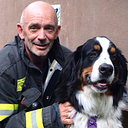Talking to Dog and Dogs Talking to Us!
Kino is a wicked smart Shih Tzu-mini-poodle cross, almost three years old. His guardians, Nick Latterell and John Shepherd — of Eden Prairie, Minnesota — noted early on that Kino seemed frustrated because the “humans” couldn’t understand what he wanted. He would bark a lot. It was hard for John and Nick to discern whether Kino wanted to go outside, have them get a toy, play with him, or it was time to eat — just lots of barking.
To help, Nick and John turned to Fluent Pet (fluent.pet) and discovered the world of augmentative and alternative communication, or AAC. Speech pathologists have traditionally used ACC to assist humans with severe language problems, for example, post-stroke, to communicate. Researchers, notably Christina Hunger, a speech pathologist in California (hungerforwords.com), began to ponder, what if we used some of the same AAC tools for dogs? The tool in question is a series of buttons expressing a recorded word or phrase when pressed. Hunger experimented with her dog Stella. Stella began using the buttons to request “outside” or “play.” She soon became fluent enough to recognize and use almost 45 words and use them in combinations.
In a word, a movement was born.
To be sure, the question, “can animals understand language?” has been asked for decades, often colored by the fact that we want to believe they can. At the turn of the 20th century, a famous horse, Hans, seemed to demonstrate the ability to count. His trainer would ask Hans to count the number of people in a crowd. He would tap his hoof until he got the correct number. This would astonish the gathered crowd and seemed to demonstrate that not only could Hans understand language, but he could also do arithmetic. But after further research, it turned out that Hans wasn’t “counting.” He was responding to the subtle cues of his trainer and the crowd. They’d get tense as he got close to the correct number and then cheer and sigh in relief when he got to the right one — and Hans would stop tapping the ground. In the study of animal behavior, this became known as the “Clever Hans” effect. Animals, especially we would think dogs, are masters at picking up on cues from the humans.
Yet the ability of dogs to use AAC seems to be a step change, especially for the right dog.
And Kino is the right kind of dog. It took him about four weeks of watching John and Nick modeling behavior — pressing the button for “outside,” saying “outside,” and then opening the door, before Kino started using the buttons, first with his nose and then with his paws.
Nick and John kept it simple at first with just a few words, like “toy,” “upstairs,” “play” and “outside.” After a few months, they noticed a few things. First, Kino seemed a lot less frustrated (with his humans!), and second, Kino used the word buttons in combination. For example, he’d press “toy, “upstairs,” “outside” in sequence, seemingly meaning that he wanted to take his toy that was upstairs out to the yard.
By the way, John recommended never having a button for “treat” because all day long, all you would hear is “treat, treat, treat.” A cautionary tale.
Here, I want to pause and consider the ramifications of using ACC for dogs.
Two things.
Laurel Braitman, a Science Historian and expert in mental illness in animals, noted, “We will always be one animal wondering about the emotional experience of another animal.” ACC may bring us closer to a better understanding of what our dogs are thinking and feeling.
Second, two scientific revolutions have moved humans from thinking we are the center of the universe to understanding that we are deeply connected to the natural world. First was Galileo Galilei pronouncing that the earth circled the sun, not vice versa. Next was Darwin and the Theory of Evolution. Here is the third: We live in a world of sentient beings. That dogs can communicate with us through words is one piece of evidence that animals think, feel, and suffer. How will we feel when a pig, using ACC, asks simply to go outside or not to be killed? These are the questions we face as we understand we live in a world of thinking and feeling beings. Like all revolutions it challenges our thinking and our sense of who we are on this planet that teems with life. The truth is we are bound together, one and all.
Hersch’s latest book, “Dog Lessons: Learning the Important Stuff From our Best Friends” is available at your favorite bookstore! Support you local bookstore and Library!
